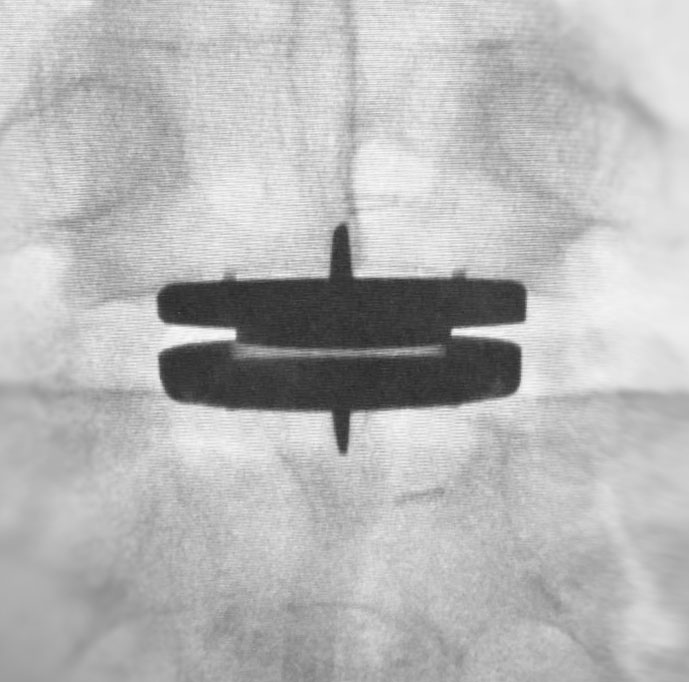What is Lumbar Disc Replacement?
 Lumbar disc replacement, or lumbar arthroplasty, is a surgery of the lower back where a degenerated disc is replaced with a motion-preserving mechanical device that mimics the natural motion previously provided by the disc.
Lumbar disc replacement, or lumbar arthroplasty, is a surgery of the lower back where a degenerated disc is replaced with a motion-preserving mechanical device that mimics the natural motion previously provided by the disc.
Our spine has three sections: cervical (upper spine/neck), thoracic (mid-back), and lumbar (lower back). The spine consists of a series of bones called vertebrae with a disc located between each vertebra. These discs serve as a cushion or shock absorbers, absorbing the impact of everyday motion. They consist of an outer fibrous layer (called the annulus) and a softer gelatinous material in the center. As we age, it is common for the discs to become worn and compressed. This is called degenerative disc disease (DDD).
Estimates suggest that 40% of adults over the age of 40 and 80% of adults over 80 suffer from this degeneration1. Studies have further identified that 50-80% of adults will experience back pain in their lifetime2. Low back pain is a very common symptom of DDD and is one of the most common reasons people see their primary care physician. A variety of non-surgical treatments are available to relieve pain and enhance mobility. However, about 10% of adults with lumbar DDD do not obtain long-standing relief from non-surgical treatments3 and in those cases, a surgical treatment can be considered.
Historically, spinal fusion has been the most common and primary surgical treatment for DDD. Lumbar Disc Replacement (LDR) or lumbar arthroplasty is a procedure that has been around for over 30 years and continues to evolve with better implants and more widespread acceptance among patients and insurance companies.
Lumbar arthroplasty involves an incision in the abdomen to access the front of the disc space. The surgeon removes the degenerated disc and replaces it with an artificial disc which preserves natural motion of the spine. A spinal fusion procedure, conversely, replaces the degenerated disc with bone graft or an implant that permanently joins two vertebrae together as one solid unit of bone—thus, reducing movement. This procedure acts to decrease pain by restricting painful movement of the arthritic spine.
The Benefits of Lumbar Disc Replacement
The benefit of Lumbar Disc Replacement is the preservation of motion in your spine. The prodisc L Total Disc Replacement, for example, is composed of two cobalt chrome alloy (CoCrMo) endplates with a polished dome that moves over an ultra-high molecular weight polyethylene (UHMWPE) ball to replicate motion.
Spinal fusion, on the other hand, limits movement across the fused segment—the two vertebrae now form a single bone with the device in the center. This transfers motion to the adjacent segment, the spinal bones and above and below the fused area of the spine, causing added stress and strain4. This additional stress and strain can lead to accelerated degeneration of the adjacent-level, creating the possibility of further pain and degeneration5.
An additional benefit of lumbar disc replacement includes a much faster recovery time6. Often, lumbar disc replacement patients are performing normal activities within weeks of surgery, compared to months with a spinal fusion. Also, no bracing is required with an arthroplasty whereas with a spinal fusion a brace is recommended for up to three months7.
Candidates for Lumbar Disc Replacement
 Typically, candidates for lumbar disc arthroplasty are patients with degenerative disc disease who have participated in conservative (non-surgical) treatments, but have not seen significant relief. Not all back pain patients are candidates for lumbar disc replacement surgery. Patients with instability, fractures, scoliosis, severe facet joint disease, post laminectomy, and other etiologies are often not good arthroplasty candidates. As previously mentioned, motion preservation is a benefit of lumbar disc replacement. However, for some patients with instability or other problems mentioned above, a spinal fusion may be the optimal treatment. Good bone quality is also a prerequisite for lumbar disc replacement.
Typically, candidates for lumbar disc arthroplasty are patients with degenerative disc disease who have participated in conservative (non-surgical) treatments, but have not seen significant relief. Not all back pain patients are candidates for lumbar disc replacement surgery. Patients with instability, fractures, scoliosis, severe facet joint disease, post laminectomy, and other etiologies are often not good arthroplasty candidates. As previously mentioned, motion preservation is a benefit of lumbar disc replacement. However, for some patients with instability or other problems mentioned above, a spinal fusion may be the optimal treatment. Good bone quality is also a prerequisite for lumbar disc replacement.
In summary, Lumbar Disc Replacement is often a good alternative to traditional spinal fusion for the treatment of degenerative disc disease and/or mechanical back pain.
 About the Author:
About the Author:
Dr. Mark Robinson is a neurosurgeon in Denver, CO, specializing in the treatment of spine disorders through both surgical and non-surgical options. Dr. Robinson attended college at the University of the Pacific in Stockton, CA and graduate school at Columbia University in New York and the University of Colorado. Following graduate school, he attended medical school at the University of Colorado, then completed his neurosurgical training at the University of Nebraska Medical Center in Omaha, NE.
These individuals can inspire your journey to healing and life after disc replacement surgery—and the hope of freedom from spine-induced pain and discomfort.
To Find a Spine Surgeon That's Right for You, Use our Surgeon Locator